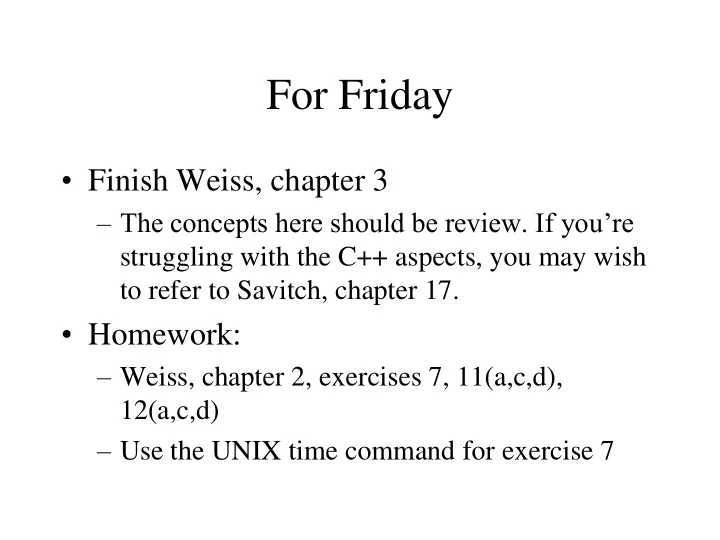

For Friday • Finish Weiss, chapter 3 – The concepts here should be review. If you’re struggling with the C++ aspects, you may wish to refer to Savitch, chapter 17. • Homework: – Weiss, chapter 2, exercises 7, 11(a,c,d), 12(a,c,d) – Use the UNIX time command for exercise 7
Homework Redux
Step Counts • Determine the number of steps in the program in terms of some input characteristic • Defining a “step” – Any computation unit that is independent of the input characteristics
Ways to Count Steps • Can actually add code to a program to count the number of executed steps – Create a global variable count – Increment count for each step execution • Step count table – List all statements in program – For each statement • determine how many steps it is worth • determine its frequency • multiply to produce total steps for the statement – Total the steps per statement
Notes about Step Counts • Need to take into account best, worst, average cases • Take all operations into account, but inexactly. • Purposes of complexity analysis are – Compare two programs that compute the same function – Predict growth in run time as instance characteristics change
Comparing Program Complexities • Suppose one program has a step count of 100n + 10 and one has a step count of 3n + 3. Which is faster? • Now suppose that one program has a step count of 100n + 10 and one has a step count of 90n + 9. Which is faster? • What if one is 3n 2 + 3 and the other is 100n + 10?
Comparing Programs • If we have two programs with complexities of c 1 n 2 + c 2 n and c 3 n, respectively, we know that: c 1 n 2 + c 2 n > c 3 n for all values of n greater than some constant • Breakeven point
Asymptotic Notation • Asymptotic notation gives us a way to talk about the bounds on a program’s complexity, in order to compare that program with others, without requiring that we deal in exact step counts or operation counts
Big Oh Notation • f(n) = O( g(n) ) iff positive constants c and n 0 exist such that f(n) <= cg(n) for all n , n >= n 0 . • Provides an upper bound for function f . • Standard functions used for g : 1 constant log n logarithmic (base irrelevant) n linear n log n n log n n 2 quadratic n 3 cubic 2 n exponential n ! factorial
Finding Big Oh Bounds • 3 n + 2 • 100 n + 10 • 10 n 2 + 4 n + 2 • 6 * 2 n + n 2 • 9 • 2045
Omega Notation ( W ) • Lower bound analog of big oh notation. • Definition: f(n) = W ( g(n) ) iff positive constants c and n 0 exist such that f(n) >= cg(n) for all n , n <= n 0 .
Theta Notation ( Q ) • Theta notation can be used when a function can be bounded from above and below by the same function.
Little oh notation • Little oh notation (o) applies when an upper bound is not also a lower bound.
Computing Running Times • Rule 1: For loops – The running time is at most the running time of the statement inside the for loop (including tests) times the number of iterations. • Rule 2: Nested loops – Analyze inside out.
• Rule 3: Consecutive statements – Add these (meaning the maximum is the one that counts) • Rule 4: if/else – Running time of an if/else statement is no larger than the time of the test plus the larger of the running times of the bodies of the if and else. • In general: work inside out.
Abstract Data Type • A specification of a data type, including the operations of the data type • Describes data items and operations in an implementation-independent way • Can be implemented as a C++ class • Could also be implemented as a set of variables and associated functions in C or another language
Linear List ADT • AbstractDataType LinearList { instances (or data) ordered finite collection of zero or more elements operations Create() Destroy() IsEmpty() Length() Find(index) // returns an element Search(key) // returns an element DeleteAt(index) DeleteValue(key) Insert(index,element) Output() }
Using an ADT • ADTs are not directly usable • They must be implemented • Most ADTs can be implemented in more than one way – What would be different ways to represent the linear list ADT?
Linked Lists • What’s the basic concept?
What Is a Node? • Two parts – Data – Pointer to the next one • Make the data public • Do provide a constructor with appropriate defaults
Creating Nodes • We’ll always create nodes dynamically. • Note that we almost never actually work with a node itself; we use pointers to the nodes. • Important: – ALWAYS initialize next to NULL when a node is created unless you are immediately assigning it another meaningful value.
C++ Details • Deleting nodes . . .
Linked List Variations • Doubly-linked lists • Empty head node
Recommend
More recommend